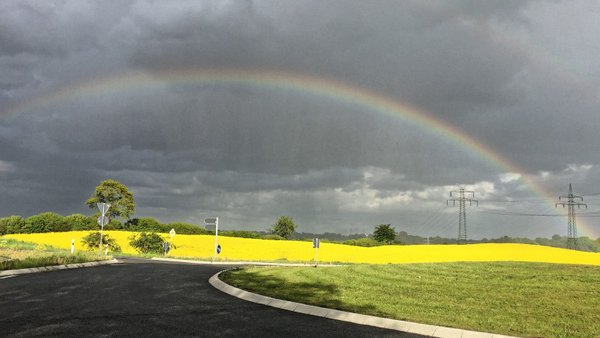The path of light - International Symposium on light scattering in Leipzig
Leipzig, 18.06.2015
Leipzig. From June 22 to June 26 2015 scientists from all over the world meet at the 15th Electromagnetic & Light Scattering Conference ELS XV.
Scattering of light at particles is a fundamental physical problem with a very broad range of applications from astrophysics to cell biology. In 2015 the triennial top conference on „light research“ is organised and run by the Leibniz-Institute for Tropospheric Research (TROPOS). The subject areas cover purest basic research on the theory of light propagation, remote sensing of surfaces, aerosols and clouds, laboratory and field measurements of light propagation, multiple scattering in planetary atmospheres, biomedical applications as well as light scattering at asteroids, meteoroids and other interplanetary objects. The theoretical basis to explore light scattering has been provided by the English scholar James Clerk Maxwell 150 years ago. For that treason the conference is also dedicated to the history of research on light from Maxwell until today.
The fact that we obtain information by our eyes, that we explore the climate of our planet from satellite or that we investigate the past of our universe in the deep sky, is possible due to the propagation of light. It gets especially interesting when light resp. electromagnetic waves are scattered at particles. That way we recognize for example clouds and haze in the atmosphere by scattering of sun light at tiny spherical water droplets and aerosols. But there are much more complex particles shapes, not only in the atmosphere, but also in many application fields like in telecommunication, in material research, medicine, astrophysics and many more.
In order to better understand how scattering of light can be modelled and measured either in the laboratory or in the field, about 120 leading scientists from all over the world meet at the 15th "Electromagnetic & Light Scattering (ELS) in Leipzig, again Germany after 2003.
Since its foundation in 1992 TROPOS intensively deals with light scattering at atmospheric particles especially for the optical measurements of air quality and for the remote sensing of clouds and aerosols with lidar systems. TROPOS is a world-leading Institute on both fields. Also for that reason the choice to organize the ELS 2015 went to TROPOS. “We are happy to host this triennial and most important international conference on the field of light scattering. The 15th ELS will also provide interesting discussions and stimulations for our future work”, says Prof. Andreas Macke, Director of TROPOS and organizer of the ELS 2015.
In this year, non-spherical and inhomogeneous particles like atmospheric ice crystals, mineral dust or interplanetary dust particles play a central role. New methods to simulate light scattering at these particles as well as new remote sensing techniques to retrieve these particles will be presented. But also aspects like scattering of sun light at the moons of Saturn or laser-based measurements of red blood cells are part of the broad range of topics at the 15th Electromagnetic and Light Scattering Conference
Konferenz:
15. Electromagnetic & Light Scattering Conference ELS XV
(22. bis 26. Juni 2015 in Leipzig)
http://www.els-xv-2015.net/home.html
Die ELS XV wird von der Europäischen Weltraumorganisation ESA, von der Europäischen Organisation für die Nutzung meteorologischer Satelliten EUMETSAT, vom Verlag Elsevier sowie vom Leibniz-Institut für Troposphärenforschung TROPOS gefördert.
Weitere Infos:
Prof. Andreas Macke, Dr. Ulla Wandinger
Leibniz-Institut für Troposphärenforschung (TROPOS)
Tel. +49-341-2717-7060, -7082
http://www.tropos.de/institut/ueber-uns/mitarbeitende/andreas-macke/
http://www.tropos.de/institut/ueber-uns/mitarbeitende/ulla-wandinger/
oder
Tilo Arnhold, TROPOS-Öffentlichkeitsarbeit
Tel. +49-341-2717-7060
http://www.tropos.de/aktuelles/pressemitteilungen/
Publikation:
Special Issue zur 14th Electromagnetic and Light Scattering Conference (ELS-XIV) (Lille, France, 17-21 June 2013):
Dubovik, O., L. Labonnote, P. Litvinov, F. Parol, and M.I. Mishchenko, 2014: Electromagnetic and Light Scattering by Nonspherical Particles XIV. J. Quant. Spectrosc. Radiat. Transfer, 146, 1-3, doi:10.1016/j.jqsrt.2014.04.006.
bisherige Pressemitteilungen zum Thema:
16.Internationale Konferenz zu Wolken und Niederschlag (ICCP 2012): 500 Wolkenforscher aus aller Welt tagen in Leipzig
Internationale Strahlungs-Symposium (IRS 2012): 500 Atmosphären-Strahlungsforscher aus aller Welt tagen in Berlin-Dahlem
Das Leibniz-Institut für Troposphärenforschung (TROPOS) ist Mitglied der Leibniz- Gemeinschaft, die 89 selbständige Forschungseinrichtungen verbindet. Deren Ausrichtung reicht von den Natur-, Ingenieur- und Umweltwissenschaften über die Wirtschafts-, Raum- und Sozialwissenschaften bis zu den Geisteswissenschaften. Leibniz-Institute bearbeiten gesellschaftlich, ökonomisch und ökologisch relevante Fragestellungen. Sie betreiben erkenntnis- und anwendungsorientierte Grundlagenforschung. Sie unterhalten wissenschaftliche Infrastrukturen und bieten forschungsbasierte Dienstleistungen an. Die Leibniz-Gemeinschaft setzt Schwerpunkte im Wissenstransfer in Richtung Politik, Wissenschaft, Wirtschaft und Öffentlichkeit. Leibniz-Institute pflegen intensive Kooperationen mit den Hochschulen u.a. in Form der WissenschaftsCampi , mit der Industrie und anderen Partnern im In- und Ausland. Sie unterliegen einem maßstabsetzenden transparenten und unabhängigen Begutachtungsverfahren. Aufgrund ihrer gesamtstaatlichen Bedeutung fördern Bund und Länder die Institute der Leibniz-Gemeinschaft gemeinsam. Die Leibniz-Institute beschäftigen rund 18.100 Personen, darunter 9.200 Wissenschaftlerinnen und Wissenschaftler. Der Gesamtetat der Institute liegt bei 1,64 Milliarden Euro. http://www.leibniz-gemeinschaft.de

